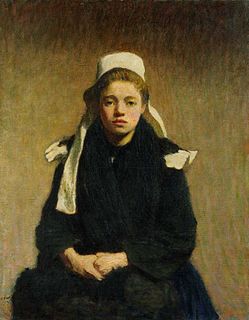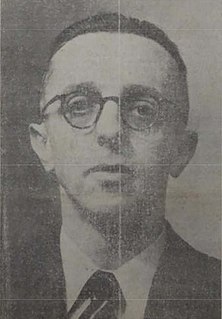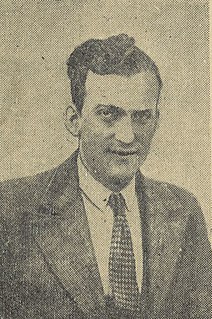
Brittany is a peninsula, historical country, and cultural area in the west of modern France, covering the western part of what was known as Armorica during the period of Roman occupation. It became an independent kingdom and then a duchy before being united with the Kingdom of France in 1532 as a province governed as a separate nation under the crown.
"Bro Gozh ma Zadoù" is the anthem of Brittany. It is sung to the same tune as that of the national anthem of Wales, "Hen Wlad Fy Nhadau", and has similar lyrics. The Cornish anthem, "Bro Goth Agan Tasow", is also sung to the same tune.

The Bretons are a Celtic ethnic group native to Brittany. They trace much of their heritage to groups of Brittonic speakers who emigrated from southwestern Great Britain, particularly Cornwall and Devon, mostly during the Anglo-Saxon settlement of Britain. They migrated in waves from the 3rd to 9th century into Armorica, which was subsequently named Brittany after them.

Olier Mordrel is the Breton language version of Olivier Mordrelle, a Breton nationalist and wartime collaborator with the Third Reich who founded the separatist Breton National Party. Before the war, he worked as an architect. His architectural work was influenced by Art Deco and the International style of Le Corbusier. He was also an essayist, short story writer, and translator. Mordrel wrote some of his works under the pen names Jean de La Bénelais, J. La B, Er Gédour, A. Calvez, Otto Mohr, Brython, and Olivier Launay.
Pêr-Jakez Helias, baptised Pierre-Jacques Hélias, nom de plumePierre-Jakez Hélias (1914–1995) was a Breton stage actor, journalist, author, poet, and writer for radio who worked in the French and Breton languages. For many years he directed a weekly radio programme in the Breton language and co-founded a summer festival at Quimper which became the Festival de Cornouaille.

Perig (Pierre) Géraud-Keraod was one of the founders of the Bleimor Scouting movement in 1946, and later founder of the Scouts d'Europe.

A Celtic circle is an association which emphasizes the Breton culture, by using possibly the Breton language.
René-Yves Creston, born René Pierre Joseph Creston, was a Breton artist, designer and ethnographer who founded the Breton nationalist art movement Seiz Breur. During World War II he was active in the French Resistance.
Maurice Duhamel was the pen-name of Maurice Bourgeaux, a Breton musician, writer and activist who was a leading figure in Breton nationalism and federalist politics in the years before World War II.
James Bouillé was a French architect based in Brittany.

Paul Émile Ladmirault was a French composer and music critic whose music expressed his devotion to Brittany. Claude Debussy wrote that his work possessed a "fine dreamy musicality", commenting on its characteristically hesitant character by suggesting that it sounded as if it was "afraid of expressing itself too much". Florent Schmitt said of him: "Of all the musicians of his generation, he was perhaps the most talented, most original, but also the most modest". Peter Warlock dedicated his Capriol Suite to him and Swan Hennessy his Trio, Op. 54.

The Revolt of the papier timbré was an anti-fiscal revolt in the west of Ancien Régime France, during the reign of Louis XIV from April to September 1675. It was fiercest in Lower Brittany, where it took on an anti-lordly tone and became known as the revolt of the Bonnets rouges or revolt of the Torrebens. It was unleashed by an increase in taxes, including the papier timbré, needed to authenticate official documents.

Joseph-Marie Jaffré, better known as Job Jaffré, was a French journalist and Breton nationalist. He also published under pseudonyms, most notably as Jos Pempoull.

Youenn Gwernig was a Breton-American poet, writer and singer. He was a painter, sculptor and a TV presenter on the French channel France 3.

The Festival de Cornouaille is an annual festival taking place in the city of Quimper, located in the south-west of Brittany (France) in July. The festival has been held since 1923 and is one of the biggest cultural events in Brittany.

Kevrenn Alre is a group of music and dance of Breton traditional inspiration, created in 1951, by railroad employees of the marshalling yard of Auray.

Coop Breizh is a Breton cultural company founded in 1957 by Kendalc'h confederation, based in Spézet, Brittany, France. Specialized in the production, the publishing and the literary and musical distribution, it propose articles related to Breton culture, Celtic cultures and the sea. Coop Breizh is the main Breton producer and distributor for books and musical creation. There are two shops : in Lorient and in Quimper.

War'l Leur is a confederacy of Celtic circles established in late 1967. Other confederacy in Brittany is Kendalc'h. The association gathers a large number of groups of Breton traditional dance which propose shows and animations throughout the Brittany region, in particular in summer, but also elsewhere in France, Europe and abroad.
Jean-Michel Guilcher was a French ethnologist. He was a researcher at the CNRS, and he taught ethnology at the University of Western Brittany. He was the author of eight books about traditional dances.

Georges Cadoudal was a French sonneur and musician. Alongside Étienne Rivoallan, he formed a group of sonneurs dedicated to the revival of Breton music after World War II. A founding member of Bagad Bourbriac, he was its penn-soner from 1953 to 1964.














